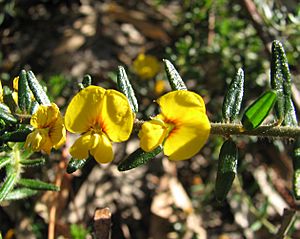Common aotus facts for kids
Quick facts for kids Common aotus |
|
|---|---|
 |
|
| Scientific classification | |
| Kingdom: | |
| (unranked): | |
| (unranked): | |
| (unranked): | |
| Order: | |
| Family: | |
| Genus: |
Aotus
|
| Species: |
A. ericoides
|
| Binomial name | |
| Aotus ericoides (Vent.) Don
|
|
| Synonyms | |
|
|
Aotus ericoides, often called the common aotus or golden pea, is a type of shrub. It belongs to the Fabaceae family, which includes many pea-like plants. This plant grows naturally only in eastern Australia. In spring, it produces pretty yellow flowers that look like peas, often with red spots.
Contents
What Does Common Aotus Look Like?
The common aotus is a shrub that can grow up to 2 m (6 ft 7 in) (about 6.5 feet) tall. Its stems often have short, tangled hairs that are rusty or grayish.
Leaves and Flowers
The leaves of this plant can be arranged in different ways. They might grow in groups of three or more, forming a circle around the stem (called a whorl). Sometimes, they grow opposite each other or in an alternating pattern.
The leaves also come in different shapes. Some are egg-shaped, wider at the bottom and narrower at the top. Others are long and thin. They are usually about 6–20 mm (0.24–0.79 in) long and 1–5 mm (0.039–0.197 in) wide. Each leaf sits on a small stalk about 1–2 mm (0.039–0.079 in) long. The edges of the leaves might curve backward or roll under. The top surface of the leaf can be smooth or have small bumps, sometimes with long hairs.
The flowers are bright yellow and look like small peas. Each flower has a red-orange band around its yellow center. The side petals, called wings, are bright yellow, as is the bottom part, called the keel. The flowers grow from the upper parts of the leaf stems.
Flower Parts and Seeds
Small leaf-like structures called bracts are found near the flowers, about 2 mm (0.079 in) long. The flower stems, called pedicels, are also about 2 mm (0.079 in) long. The outer protective leaves of the flower, known as the calyx, have pointed tips and are covered with soft, long hairs, about 3 mm (0.12 in) long.
After flowering, the plant produces a seed pod. This pod is firm, egg-shaped, and covered with soft, long hairs. The common aotus usually flowers from late winter to spring.
How It Was Named
The common aotus was first officially described in 1803 by a French botanist named Étienne Pierre Ventenat. He first called it Pultanaea ericoides. His description was published in a book called Jardin de la Malmaison.
Later, in 1832, a Scottish botanist named George Don changed its name to Aotus ericoides. This new name was published in his book, A General History of Dichlamydeous Plants.
The second part of the plant's scientific name, ericoides, means "like Erica." This is because the plant looks similar to species in the Erica genus. The ending -oides comes from Latin and means "likeness" or "resembling."
Where Common Aotus Grows
You can find the common aotus growing in eastern Australia. It likes to live in areas with heathland (open shrubby land) and dry sclerophyll forests. These forests often grow on sandstone soil.
It is found in several Australian states:
- Queensland
- New South Wales (especially along the coast and in the Southern Highlands)
- Victoria
- Tasmania
- South Australia

